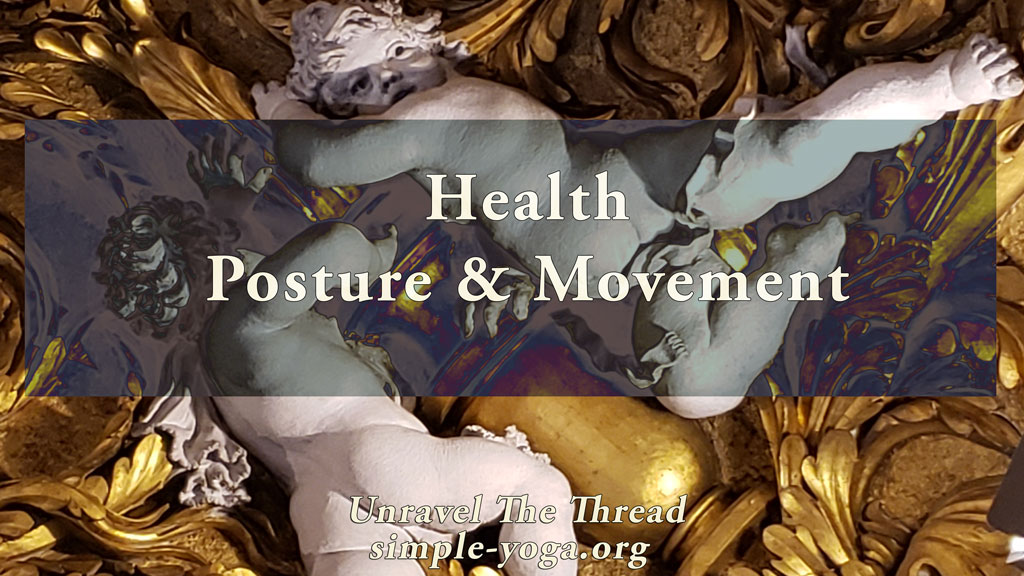
Health, appetites and elimination (part 2)
September 14, 2024
Health, calm mind, cheerful attitude (part 4)
October 22, 2024
Health, appetites and elimination (part 2)
September 14, 2024
Health, calm mind, cheerful attitude (part 4)
October 22, 2024Health, optimal posture and graceful movement (part 3)

Health, optimal posture and graceful movement (part 3)
In today’s episode we continue our exploration of our comprehensive definition of health. Here is the definition once again: Health is the harmonious integration of adequate appetites, efficient elimination, optimal posture, graceful movement, cheerful attitude, calm mind, and compassionate interaction.
Having explored some basic ideas about our appetites and elimination, we are ready to consider posture and movement. In recent years, there have been countless discussions about the physical practice of yoga and the possible relationship, or lack thereof, between postural yoga as it is practiced today and earlier and ancient practices. Some of these discussions assume that there was an ideal yoga practice at some point in the past; other conversations consider the many sources of cross-pollination that have helped to shape contemporary yoga practice. In some cases, practitioners may be interested in finding the ideal approach to practicing the postures and movements for a particular goal. For some, the practice of asanas and vinyasas offers a way to heal an ailing body, for others a way to make the body strong and impervious to disease and illness, still others practice yoga to make the body beautiful or to purify the body so that it is a worthy vessel for our conscious awareness. Clearly, there is a whole spectrum of approaches to the practice of the postures and movements, including their role in a system focused on transcendence. So it is useful to consider, what are the reasons you have for practicing yoga postures and movements? Asking ourselves this question can help us ensure that our practice meets our goals. As we reflect on our answers to this question, we may find that some of our reasons overlap or change over time. Would it be useful for us to revisit this question from time to time? Can it help us notice if and how our perspective and motivation for practicing might change over time? In addition, answering this question can also remind us of how our practice aligns with our overarching goal.
Let’s start thinking about the idea of optimal posture with a little anecdote. Over 20 years ago, while living in Thailand, I noticed that in many places people would squat down to wait for transportation, to just hang out and chat, and they seemed quite comfortable. On some occasions I also noticed that many people were comfortable sitting on the ground for long periods of time. Although I was already practicing yoga postures every day, it was humbling to realize that neither my floor sitting nor my squatting were optimal, because it was rather uncomfortable for me to sit or squat with the same ease as the people around me. I had not given it much thought at the time because I had not attempted or needed to squat for long periods of time. In short, the meaning of what is optimal is likely to be different for different people, and even for the same person in different contexts. In other words, our understanding of what is optimal posture needs to be flexible because our optimal posture will most likely be influenced by our personal history, context, circumstances, needs, and activities.
When we consider the myriad variations in contemporary physical yoga practices, it may often seem that the three sutras dealing with asana in Patanjali’s Yoga Sutra are insufficient to address all the vast number of possibilities for practice. It has been argued that the asanas Patanjali was referring to were only about sitting positions. However, I would like to invite you into this reflection on posture and movement as important elements of health by looking at posture and movement through Patanjali’s instructions in Sutras 2.46 and 2.47. Let’s start with the idea that optimal posture includes the idea that one can have steadiness and ease (or a pleasant steadiness) in posture, as Patanjali suggests in Sutra 2.46. Let’s not ignore Sutra 2.47, which also instructs us to drop effort and focus on infinity. Releasing struggle or minimizing effort in Sutra 2.47 suggests how to get into that state of comfortable steadiness. We can explore this idea by noticing if increasing effort seems to create an inner sense of constriction and stress. Is it possible that releasing efforts contributes to release congestion in our bodies and in our nervous system? But what about the idea of focusing on infinity? One possible interpretation is that in the posture we transcend the body, mind, and emotions. Another way of thinking about focusing on infinity is that Patanjali invites us to focus on the ever-changing infinite now moment. In other words, we focus on infinity by paying close attention to the experience (including sensations, emotions, thoughts, memories) of the now moment before entering the posture, maintaining this focus on the next now moment-all the changing aspects of our experience-while we remain in the posture, and then maintaining our focus on the next now moment as we release the posture. In summary, these two sutras suggest that there are four components in the practice of yoga postures, including a combination of firmness and comfort, effortlessness and focus on infinity. We have not yet included the third sutra on asana, 2.48, because instead of giving us instructions on how to practice, it tells us the results of practicing according to those instructions.
One perspective on practicing a posture consists of thinking of the posture as a purely physical endeavor, a series of muscular actions that make a combination of joints to lengthen, flex, extend, or rotate. It may also be possible to think about posture as a physical process originating in the brain and accomplished through instructions sent and received through the nervous system. For instance, it is possible to think about a posture, like sitting in a chair or being in the standing up position as the result of some muscles shortening and others lengthening to act on specific body joints. The other option indicates that the person probably does not think about the specific muscle and joint actions required to be in a seated position or standing, they just think about coming into that posture. It is useful to think about postures as a combination of those two perspectives that also includes attending to the sensations that compose our experience so that we can use them as feedback for refining our actions in alignment with our intention. Graceful movement is an organic extension of optimal posture (comfortable steadiness, economy of effort and focus on infinity) for accomplishing an intended action. Highly skilled dancers are an excellent example of graceful movement; it seems like their bodies are weightless and that their movements are effortless. When we observe a person skilled in a craft, like writing, painting, drawing, dancing and other movements, we notice that it seems like they approach the movement process with simplicity, economy of effort and playful curiosity that translates into graceful action that can be modulated with great precision. Perhaps their ways of moving offer us momentary glimpses of a state of superb focus and being beyond duality, the latter being the results of asana, according to sutra 2.48.
In our definition of health, it is important to keep in mind that optimal posture and graceful movement are individual, and that what may seem to an external observer as suboptimal may not keep into account the context and personal history of the person observed. What are the qualities of posture that would make specific postures optimal for you at this point in your life? What are the qualities that contribute to make your movements graceful at this point in your life? What is the mental, emotional and physical feedback indicating ways to make your posture optimal for this moment? What feedback offers you ways to enhance the quality of your movements? Can thinking about your posture from a physical perspective offer you insights to make your posture optimal and your movements more graceful? If so, does that contribute to enhance the quality of your experience? Although we did not mention breathing as a specific component of posture and movement, is it obvious to you that modulating our breathing processes can influence the qualities of your postures and movements?
Rather than thinking about specific expressions of posture and movement as ultimate goals to be achieved or conquered, can we think of optimal posture and graceful movements as invitations to exploring the range of possibilities available to us in the moment we are practicing? Similarly, we can consider, what are the ways in which we can regulate muscular engagement, joint action, direction and speed of movement and their interrelations to our attitude, intention and focus?
Additionally, although today’s exploration was focused mostly on physical postures and movements, it may be useful to remember that we also tend to hold certain postures in our attitudes, our thoughts, our ways of thinking and our emotions, and that those postures manifest in our bodies, our intentions, and in our actions and interactions. Can our ways of acting constitute a form of movement? Are those ways of acting graceful?
Let’s return to the idea of integral health and to the notion that the quality of our posture and movement can serve as indicators of our general state of health. Do you agree? Or do you disagree?
I trust that contemplating the questions in this episode can be useful for you in designing physical yoga practices that contribute to your health. I also hope that enhanced posture and movement have a positive influence in your life.
If you prefer, you may listen to the podcast:
This is an excerpt from the book Unravel the thread: Applying the ancient wisdom of yoga to live a happy life
If you find Simple-Yoga.org and Unravel the thread useful, consider supporting my labor with a donation, you may also donate using PayPal or Venmo. Thank you!
